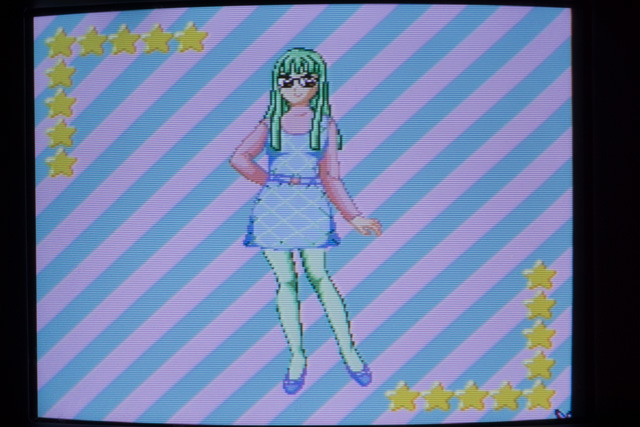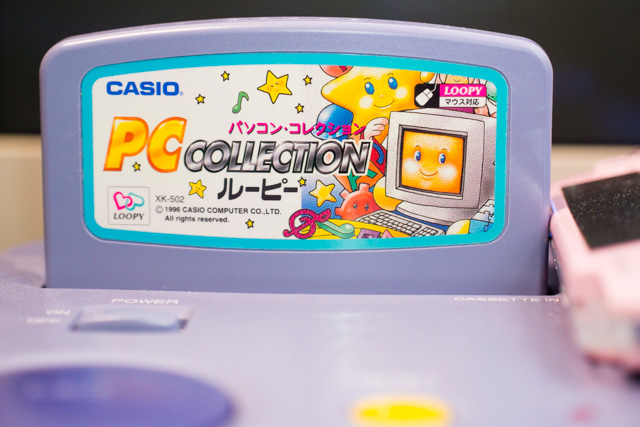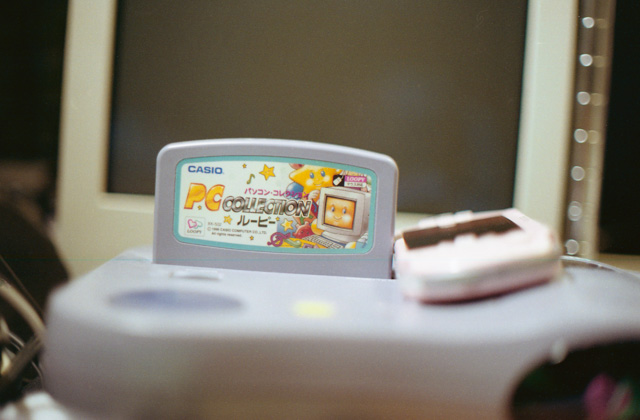The Casio Loopy
The Casio Loopy is the weirdest console I own. I love it. Of course a girls targeted game console exists. But, it’s from 1995. It uses cartridges. It prints stickers. It uses a color thermal dye sublimation printer. Uses budget 2D hardware for the time. It’s from Casio. It’s not from some American brand that would have made some pink sludge product, not from Mattel, nor a Takara/Tomy/Bandai thing. Well, maybe a little less from left field in Japan where maybe the more feminie/girly Casio organizers/music toys were more available. It’s got a sticker printer, but wasn’t a trend follower or starter. Yes it had Magical Shop, the video input cartridge, but I highly doubt too many people bought it. It was concurrent with prikura, so not responsible/a result of prikura (Those photobooths for making stylized pictures and print to stickers.). It had onboard sound, but some carts also had additional sound on cart. At the time, if a music company had music hardware in a thing it was Yamaha. This is Casio. That’s weird for 1995/96.

Is it Bad, like someone might say*? No. I actually don’t believe it failed for being bad or awful. Bad timing and limited market? For sure. Multiple pieces of undercooked software? Yes. I’ve not gotten around to actually cataloging it but when looking into NEC PC-98 stuff and Japanese Saturn and Playstation libraries, I actually found almost no parallels to what the Loopy got for software. Going through Kisekae Set System archives it seems it peaked later, and only covers dress-up games. Well, part of them. KiSS dolls are certainly more paper doll sets. I don’t know how Japanese kids used the internet in the late 90’s either, so I’m never certain how sharing evolved with that on their end. I can certainly say Anime Boom era kids certainly latched on and played with KiSS dolls of characters from their favorite shows. And their OCs. The loopy is a full software step above kid laptop type products that surely existed there during this time. Bandai’s products from that time seem to overlap with the Loopy’s but also aim younger. Commercials I’ve run into for girls have kids slightly younger than Loopy’s and the Playdia is really aimed at the early education market. Like, younger bracket for DBZ/Sailor Moon and the Anpanman crowd in the mid-90’s at highest. Japan still got a lot of 2D games on Saturn and Playstation, still got anime games aimed at kids, but couldn’t find something like the dress-up light fashion/modeling sim Dream Change. (I should probably dive back in again, but I could guess that maybe some of those kids focused games on PS1 were Bandai.) I banged my head through part of it, with my limited Japanese, to try and see if more clothes were unlocked later. (Full outfit stuff is unlocked early, but maybe more further.) What I could tell was it was also trying to teach about fashion terms. Maybe some of it was just ‘that top works best with that skirt’ and such, but I remember having to look up Japanese material or pattern terms.

The few games I was able to get, the more game-like stuff seemed repetitive. It got boring real quick. It seems like at various points, Anime Land, Dream Change, and Wanwan Aijou Monogatari were the pack-in games. (Maybe others too, I think there’s a PC collection bundle.) Either solo, two of them, or stores doing it manually. Dream change can get very repetitive fast and I wonder how tolerable it was to the people who owned it in 1996 or later. Did a girl have some friends/relatives over and then after a few hours of playing around and printing a few outfits drop it? Or did it become a thing where the kids were overly cautious about using up the print roll? Were the Japanese parents who bought this typically that wary of buying consumable products like that? I also want to try Loopy Town if I get a ‘cheap’ copy or when emulation finally works well.
PC Collection is the one that I want to know more about. It’s kid’s software where computer-like tasks can be done on it. Computer stuff but for kids! It’s a software suite. It’s built for the mouse controller. You can draw, you can make music, etc. What I really want to look into is the dress-up feature in it. It’s got it’s own set of digital paper doll stuff, with its own color palette, and it is considered part of a software suite. It makes me wonder if there’s something specific on PCs at the time that influenced it or if it was just a fashion games for girls feature. While it wouldn’t surprise me that “we just thought this is how it should be” is the reason to how it was made, but what did come before? If it is just KiSS, then what was pre-internet KiSS like for kids… What I have found pre-1998 is more H than that. While the R18 stuff certainly also has a lack of English documentation/coverage, certainly covering who else got to use the computer and what they did on it is important.

*Ok, so when trying to look up the exact sound chips because I wanted to check if it was common to other Casio products… I ran into multiple ‘Casio Loopy Bad’ things. A lot of that seems to lack a huge context from the era. Though, throughout this blog post I’ve had to remind myself when things happened because the design language in some of these feels a year or two older than the 1995/1996 release times. Even then, I’m only saying 1994 because there’s hints of CG through some of the titles. Some of the fashion in Dream Change feels era appropriate, but some of the outfits in that game and PC Collection wouldn’t look out of place in the earlier part of the 90’s, if not even late 80’s. I can’t exactly pinpoint what makes that feeling but it doesn't feel like things kids a little younger than me latched onto in the late 90's/00’s, so despite being a ‘modern’ software/hardware device it’s not revolutionary. Still feels off for the mid 90’s, kids using digital dress up dolls here were online afew years after the Loopy existed. That said, I grew up in a Disney zone so it’s taking a little effort to remember not-Disney and not-Sailor Moon/anime boom for stuff marketed at girls. I do feel it may have come a little on the edge of ‘late’ for the kind of girly it was marketing, but… shooting from my hip I think it may have been selling to the parents, of a certain class that could afford this, as much as the kid. Sometimes you have to tell the parent this is a thing their kid wants using the Parent’s language. Also I don’t think it’s a good idea to just poo poo girly things, especially for just being a type of feminine. (Certainly a crit exists around companies’ use thereof, but when it comes to Loopy I have rarely seen it incorporate the context where, when, and who it was targeted at and who made those decisions for what reasons.) It certainly sounds like girl’s product wasn’t the initial seed for this project either. Femicom Museum has a lot of info, but not fully detailed. Eurogamer’s Lewis Packwood tracked down two engineers and… I really really wish more info was gotten outta them. Also wish we had a more thorough record from people who owned one. The few hints I have at how it was really used is someone actually used the notes section in the manual to one of the games I have and put the stickers in there.
I may be rambly, low effort, and poorly thought out but if I’m gonna swing a “this is bad” hammer I don’t wanna hit my thumb. Just mess up the nail.


